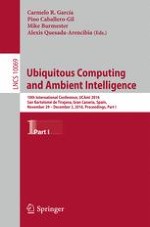2016 | OriginalPaper | Chapter
Findings About Selecting Body Parts to Analyze Human Activities Through Skeletal Tracking Joint Oriented Devices
Authors : Carlos Gutiérrez López de la Franca, Ramón Hervás, Esperanza Johnson, José Bravo
Published in: Ubiquitous Computing and Ambient Intelligence
Publisher: Springer International Publishing
Activate our intelligent search to find suitable subject content or patents.
Select sections of text to find matching patents with Artificial Intelligence. powered by
Select sections of text to find additional relevant content using AI-assisted search. powered by
